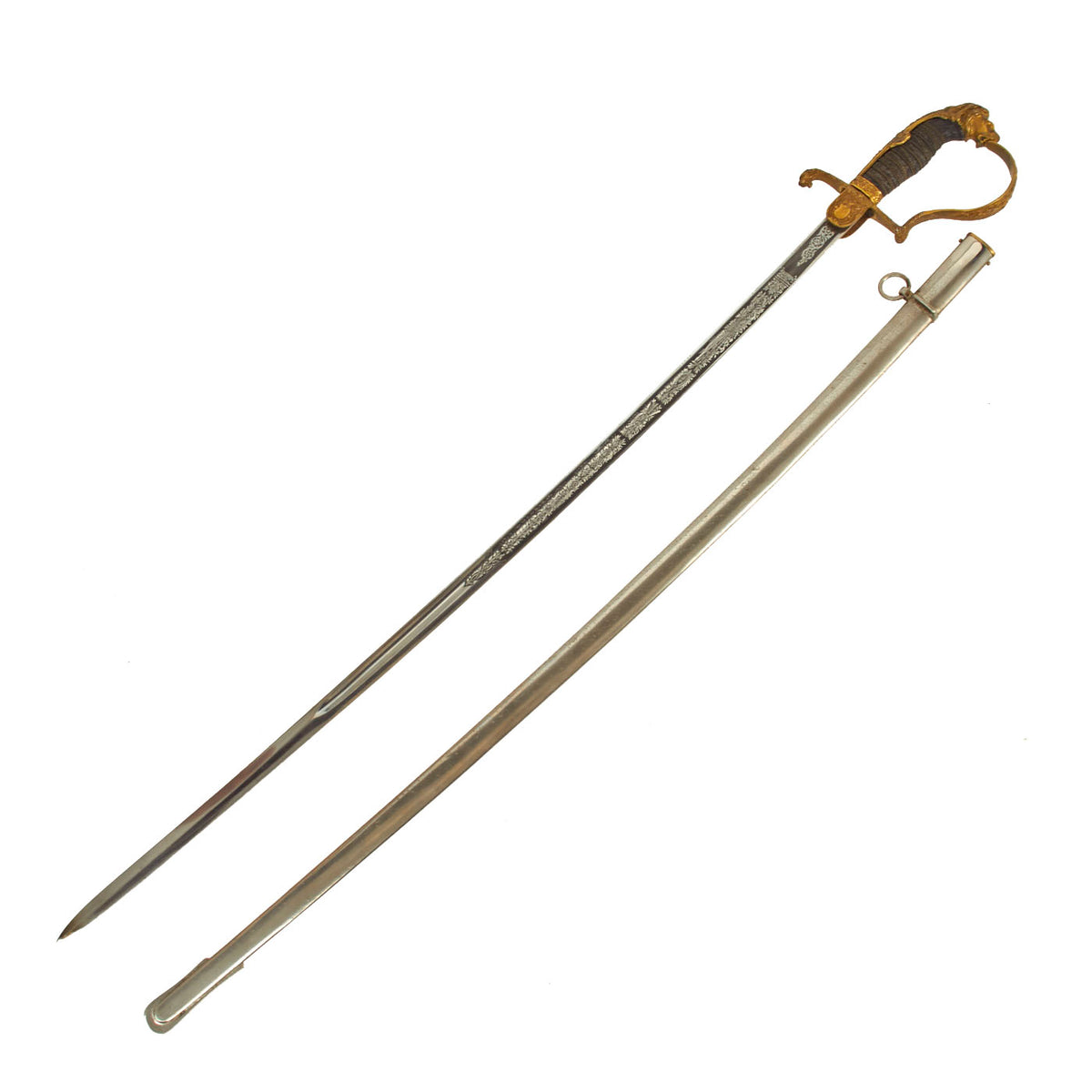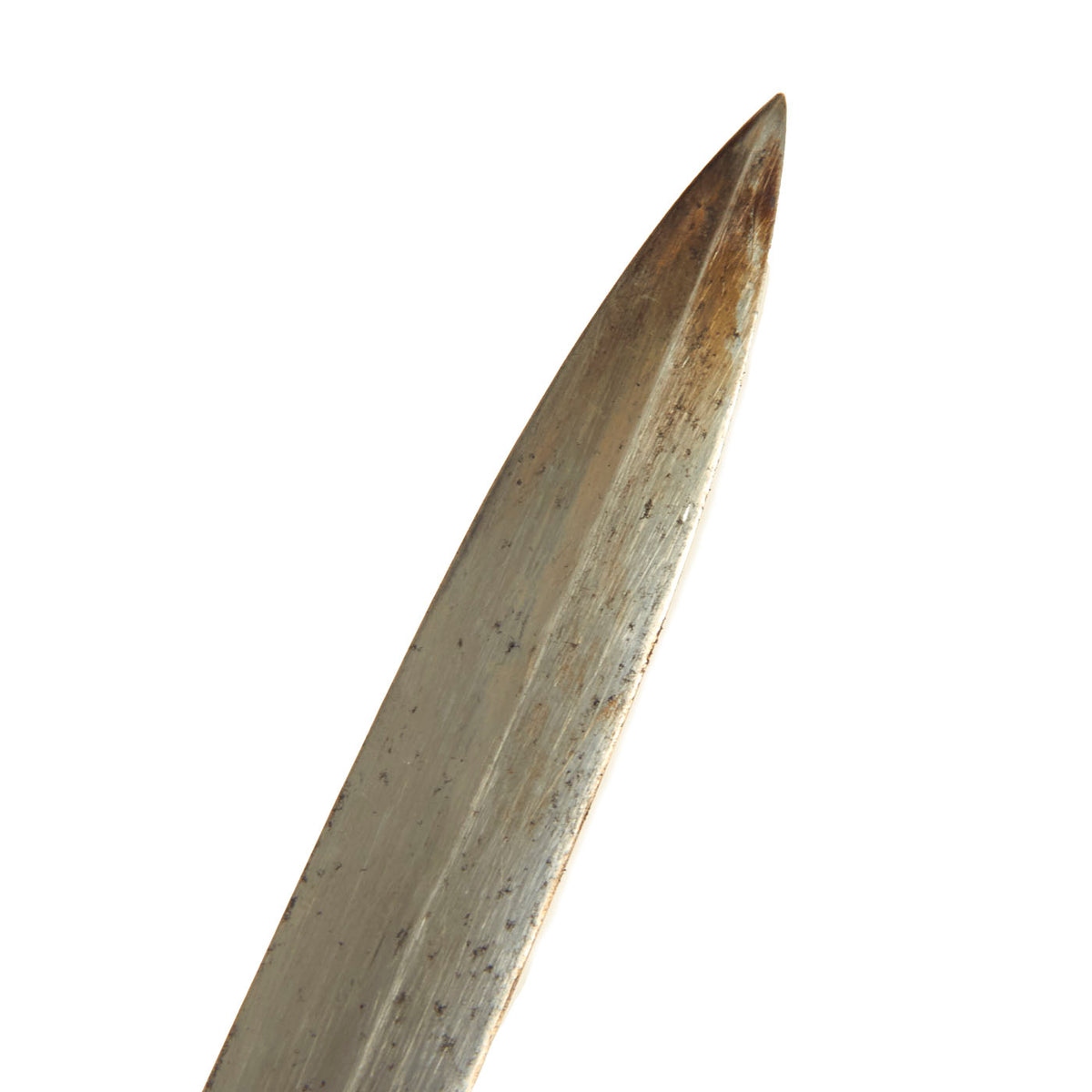Original German Pre-WWII Weimar Republic Lion’s Head Reichsheer Officer Sword by Wilkinson Sword Co of London Original Items
$ 595,00 $ 178,50
Original Item: Only One Available. During the years immediately following the Armistice that ended WWI, German industry as a whole was in shambles. The country was occupied by the Allied powers, and there were severe restrictions on anything related to weapons construction.
However, Germany still did need to have armed forces of some level, and they needed officer’s swords just like any military. It looks like during this time outside contractors such as the famous Wilkinson Sword Company were allowed to manufacture and retail swords within Weimar period Germany. This sword conforms very well to the typical German “Lion’s Head” pattern, and even has the “oak leaves and acorn” motif on the inside of the “P” shaped guard.
The sword has a 32 1/2″ nickel plated blade, etched with standard infantry style motifs as well as much floral work. The blade is in excellent condition, and still has the original unsharpened blunt edge. It is etched with the Wilkinson logo on the ricasso, partly obscured by one of the langets:
(Coat of Arms)
BY APPOINTMENT
WILKINSON
SWORD
Co. Ld.
LONDON
It is also marked MADE IN ENGLAND on the spine, which dates the sword to the early 1920s, when new import restrictions for the United States dictated clearly marked country of origin markings. Makers worldwide had no reason to have different formats for specific countries, so they all added origin markings of a similar form.
The sword has a very nice wire wrapped sharkskin grip, common for higher end WWI era swords. Aside from the Royal Coat of Arms that is a part of the Wikinson markings, there are no Royal Cyphers or any other kind of identifying markings in the etching or elsewhere. This may have been to disguise where the sword was going, or was intended to be marked later.
The included nickel plated brass fit scabbard is in very good condition, with the plating retained well, showing light overall oxidation and a bit of bubbling.
A very nice Interwar Period sword by Wilkinson, most likely made for the German market. Ready to research and display!
Specifications:
Blade Length: 32 1/2″
Blade Style: Single Edge w/ Fuller
Overall length: 37 3/4“
Guard: 5″L x 5 1/2″W
Scabbard Length: 33″
The Weimar Republic (German: Weimarer Republik), officially the German Reich (Deutsches Reich), also referred to as the German People’s State (Deutscher Volksstaat) or simply the German Republic (Deutsche Republik), was the German state from 1918 to 1933. As a term, it is an unofficial historical designation that derives its name from the city of Weimar, where its constitutional assembly first took place. The official name of the republic remained the German Reich as it had been during the German Empire because of the German tradition of substates.
Although commonly translated as “German Empire,” Reich here better translates as “realm” in that the term does not necessarily have monarchical connotations in itself. The Reich was changed from a constitutional monarchy into a republic. In English, the country was usually known simply as Germany, and the Weimar Republic name became mainstream only in the 1930s.
The Reichswehr (English: Realm Defense) formed the military organization of Germany from 1919 until 1935, when it was united with the new Wehrmacht (Defense Force). At the end of World War I, the forces of the German Empire were disbanded, the men returning home individually or in small groups. Many of them joined the Freikorps (Free Corps), a collection of volunteer paramilitary units that were involved in suppressing the German Revolution and border clashes between 1918 and 1923.
The Reichswehr was limited to a standing army of 100,000 men, and a navy of 15,000. The establishment of a general staff was prohibited. Heavy weapons such as artillery above the caliber of 105 mm (for naval guns, above 205 mm), armored vehicles, submarines and capital ships were forbidden, as were aircraft of any kind. Compliance with these restrictions was monitored until 1927 by the Military Inter-Allied Commission of Control.
The Reichsheer was the Army Division of the Reichswehr.
Fast Shipping with Professional Packaging
Thanks to our longstanding association with UPS FedEx DHL, and other major international carriers, we are able to provide a range of shipping options. Our warehouse staff is expertly trained and will wrap your products according to our exact and precise specifications. Prior to shipping, your goods will be thoroughly examined and securely secured. We ship to thousands clients each day across multiple countries. This shows how we're dedicated to be the largest retailer on the internet. Warehouses and distribution centres can be located throughout Europe as well as the USA.
Note: Orders with more than one item will be assigned a processing date depending on the item.
Before shipping before shipping, we'll conduct a thorough inspection of the items you have ordered. Today, the majority of orders will be delivered within 48 hours. The delivery time will be between 3-7 days.
Returns
The stock is dynamic and we cannot completely manage it because multiple stakeholders are involved, including our factory and warehouse. So the actual stock may alter at any time. It's possible that you may not receive your order once the order has been made.
Our policy is valid for a period of 30 days. If you don't receive the product within 30 days, we are not able to issue a refund or an exchange.
You can only return an item if it is unused and in the same state as the day you received it. You must have the item in its original packaging.
Related products
Uncategorized
Uncategorized
Uncategorized
Uncategorized
Uncategorized
Uncategorized
Uncategorized
Uncategorized
Uncategorized
Uncategorized
Uncategorized
Angolan Rebel 1970s era 60mm Inert Display Mortar from Angolan Civil War Original Items
Uncategorized
Uncategorized
Australian WWII Owen MK1 Machine Carbine SMG Custom Fabricated Replica with Sling Original Items
Uncategorized
Uncategorized
Band of Brothers ORIGINAL GERMAN WWII Le. F.H. 18 10.5cm ARTILLERY PIECE Original Items
Uncategorized
Uncategorized
Uncategorized
Armoured Fighting Vehicles of the World: AFVs of World War One (Hardcover Book) New Made Items












































































